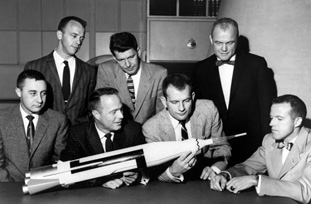Many people gathered to watch Discovery's launch
Click on image for full size
Images courtesy of NASA
STS-95 Launch: "Let the wings of Discovery lift us on to the future."
News story originally written on October 30, 1998
The Space Shuttle Discovery lifted off from Kennedy Space Center at 2:19
p.m. EST, October 29th. The sky was clear and the weather was great as
Discovery took 8 1/2 minutes to reach orbit for the Unitied States' 123rd
manned space mission.
Crowds of people turned out to watch as
John
Glenn returned to space for the second time in 36 years. People who
watch shuttle launches regularly said that the crowd was a lot larger than
during most recent shuttle launches. In addition to the people watching
in person, the launch was covered live by many major broadcast stations as
well as on different internet sites.
Discovery was scheduled to launch at 2 p.m. EST but was delayed for nine
minutes when an alarm in the cockpit sounded. Once the countdown was
resumed, had to be stopped again because a private airplane entered the
restricted airspace around the launch site. An Air Force plane escorted
the intrusive pilot out of the area.
There may have been one problem during the launch. NASA officials
believe a panel struck one of the engines. The panel was possibly a door
which was covering a drag chute used to slow the shuttle during landing.
They believe that it is unlikely that the incident will affect the
mission or the landing.
The crew for the nine-day mission consists of: Curtis L. Brown as
commander; Steven W. Lindsey as pilot; Stephen K. Robinson, Scott E.
Parazynski, and Pedro Duque as mission specialists; and Chiaki Mukai and
Glenn as Payload Specialists.
You might also be interested in:

In 1959, John Glenn was chosen to be a Project Mercury Astronaut. In fact, he was given "go" to pilot the Mercury-Atlas 6 'Friendship 7' spacecraft on the first manned orbital mission of the United States
...more
It was another exciting and frustrating year for the space science program. It seemed that every step forward led to one backwards. Either way, NASA led the way to a great century of discovery. Unfortunately,
...more
The Space Shuttle Discovery lifted off from Kennedy Space Center at 2:19 p.m. EST, October 29th. The sky was clear and the weather was great as Discovery took 8 1/2 minutes to reach orbit for the Unitied
...more
A moon was discovered orbiting the asteroid, Eugenia. This is only the second time in history that a satellite has been seen circling an asteroid. A special mirror allowed scientists to find the moon
...more
Will Russia ever put the service module for the International Space Station in space? NASA officials are demanding an answer from the Russian government. The necessary service module is currently waiting
...more
During a period of about two days in early May, 1998, the ACE spacecraft was immersed in plasma associated with a coronal mass ejection (CME). The SWICS instrument on ACE, which determines unambiguously
...more
J.S. Maini of the Canadian Forest Service has referred to forests as the "heart and lungs of the world." Forests reduce soil erosion, maintain water quality, contribute to atmospheric humidity and cloud
...more









